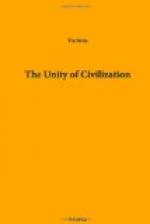The plough is less easy to trace. All that can be safely said at present is that it is a device for applying the strength of large cattle to break up the soil for a grain crop, deeply and uniformly, and above all more rapidly than a man can dig it with a hoe. By his own effort a man can barely break up enough ground to supply his home with grain, except in irrigated land. With the simplest of ploughs he can do this and more, and yet have leisure for other pursuits within the ploughing season. But it is not yet clear in what region ploughing first began. Probably it was in the comparatively well-watered and well-wooded margin of one of the large grasslands; but whether north or south of the Mountain Zone, or round the discontinuous plateaux within it, is not clear. The presumption of large cattle favours the north, yet Babylonia, and even Egypt, had large cattle from very early times. North Syria seems to dispute with Babylonia priority in the production of wheat. Somewhere in this region we may provisionally place the cradle of what I may perhaps describe as the Bread-and-Cheese culture, in which the staple foods are provided by grain-plants and cattle, the latter being valued for their strength and their milk products, but not primarily for their flesh.
Disseminated westward, the Bread-and-Cheese culture is found to suffer regional modification. Southward, among the Mediterranean evergreen flora and old hoe-cultivation, the dearth of summer grass makes the large cattle useless for milking, as well as for beef; they are bred exclusively for draught, as their gait and structure show, and while cheese is supplied by the sheep and goats, butter and animal-fats are replaced by the vegetable oils, of which the olive is the chief, a characteristic Mediterranean product, evergreen, deep-rooted against summer drought, and fleshy-fruited. A Bread-and-Olive culture results, familiar to all visitors to Mediterranean lands. In the deciduous forests of South-Central Europe there is grass in the clearings, and milk enough; but goats and sheep are restricted, as the undergrowth becomes deeper and denser, and the prime giver of fats is the forest-bred pig: in a land rolling with ham and sausages we reach the Bread-and-Bacon culture. Further afield still, and later, in proportion as the forest is opened out by semi-pastoral folk, the moister summer permits open meadow-land, with perennial grass, and the possibility of hay. Here too the grain crops may be so large that there is something over to fatten stock; and to Bread and Cheese the farmer of the north-western plains adds Beef. When there is coarse grain in plenty, of course, the large-boned horse of the north gradually replaces the ox at the plough, and permits him to be bred, as with ourselves, not for draught at all, but for milking and killing exclusively. It is in this final phase that the Bread-and-Beef culture passes over eventually into the New World, and into the South Temperate Zone. It has been




